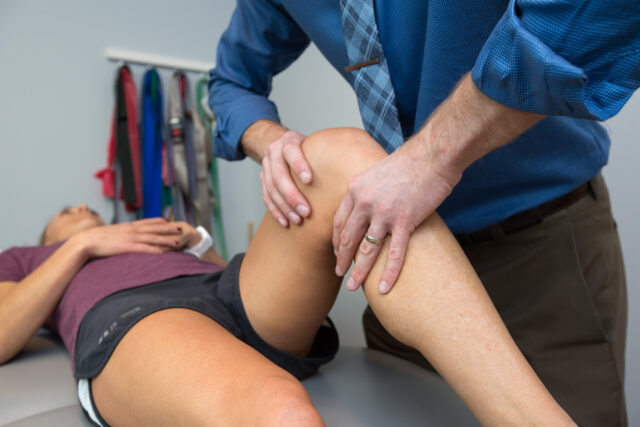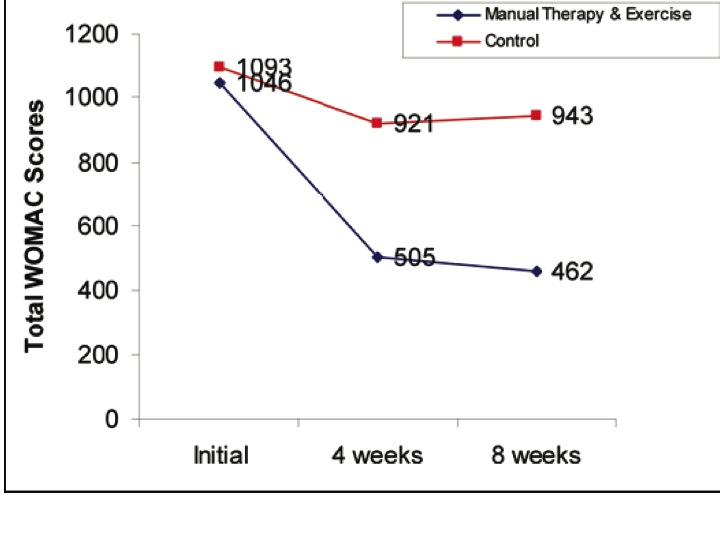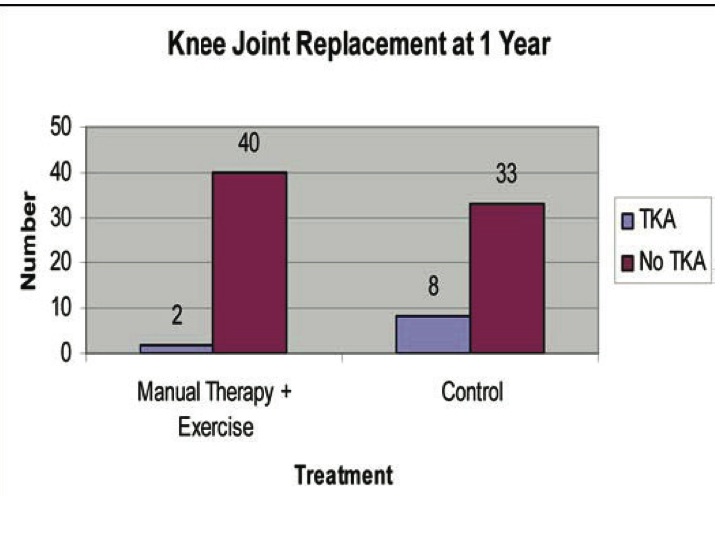Knee Arthritis Background Information
Osteoarthritis (OA) costs have risen to 13.2 billion dollars per year and is the leading cause of disability in adults (1).
Knee OA is the most common area affected and leads to mild to moderate disability in more than 10% of adults over age 55 (2). Up to 70% of older adults may show OA changes on imaging, yet remain asymptomatic (3).
The clinical examination has also been shown to help in the ruling out (sensitivity 0.91) and ruling in (specificity of 0.86) using the following findings (4).
Physical Therapy Treatments for Knee Arthritis
A multimodal approach is utilized in the management of OA, including activity modification, weight reduction, education, manual therapy (including joint mobilization/manipulation), soft tissue treatments, and exercise (7,8).
Grade A Oxford Level of Evidence is found with a manual therapy and exercise approach to knee OA (9).
Exercise is recommended by all clinical guidelines for the management of knee OA (5,6).
Evidence for Physical Therapy Management of Knee OA
Deyle et al. demonstrated improvements in pain, disability, and function following physical therapy, including manual therapy and exercise interventions. Some patients reported a 20-40% improvement in just 2-3 visits. This program also delayed or prevented the need for total knee replacement in some participants (9). See figures at the right.
Authors have reported manual therapy to be more clinically and cost-effective compared to usual medical care for the treatment of knee OA, with improvements noted up to one year (11,12).
In addition, manual therapy and exercise were twice as successful as a home program for the short-term improvement of pain and function (1,3).
Cochrane Reviews support the utilization of exercise to alleviate symptoms of OA, as well as improve strength and physical fitness (10).
Treatment for Knee Pain in Boulder and Lafayette: A Multi-Faceted Approach
At Mend Colorado, we understand that knee pain can significantly impact your quality of life, especially for those who enjoy an active lifestyle. Whether you’re hiking, biking, or practicing yoga, knee pain can be a barrier to living your best life. Fortunately, there are effective treatments for knee pain in Boulder and Lafayette that can help restore mobility and reduce discomfort.
Our team of fellowship-trained physical therapists specializes in personalized treatment plans for knee pain, focusing on a combination of manual therapy, targeted exercises, and advanced techniques like dry needling to provide relief from painful knees. We’ll work with you to create a plan that fits your specific needs and goals, helping you get back to the activities you love.
Knee Pain Symptoms and Treatments: How Physical Therapy Helps
Knee arthritis typically presents with symptoms such as pain, stiffness, swelling, and difficulty with mobility. Many people also experience discomfort when walking, climbing stairs, or engaging in other activities that require bending the knee. Physical therapy can help address these symptoms and improve knee function.
Tailored treatments, such as manual therapy and exercise, are proven to alleviate knee pain symptoms and improve strength, flexibility, and overall function. The goal is not only to reduce pain but also to increase joint stability and enhance mobility, making everyday activities easier and more enjoyable.
Why Choose Mend Colorado for Knee Pain Treatments in Boulder and Lafayette?
Mend Colorado’s team of board certified, Doctors of Physical Therapy is dedicated to providing the highest level of care for those suffering from knee arthritis and knee pain. Our approach is evidence-based, compassionate, and tailored to the unique needs of our patients.
We’re well-versed in the specific challenges that active Colorado residents face when dealing with knee pain, and we’re here to offer expert treatment for knee pain in Boulder and Lafayette that can help you regain mobility and get back to doing what you love.
Whether you’re dealing with chronic knee pain, recovering from a sports injury, or managing the symptoms of osteoarthritis, we have the knowledge and expertise to create a comprehensive treatment plan for your knee pain symptoms and treatments.
When to Seek Physical Therapy Care for Knee Pain
If you’re experiencing knee pain that affects your ability to walk, climb stairs, or participate in activities you enjoy, it may be time to seek professional treatment. At Mend Colorado, we recommend seeing a physical therapist if you’re struggling with any of the following symptoms:
- Persistent knee pain, especially when moving or weight-bearing
- Stiffness or swelling that limits joint mobility
- Difficulty with daily activities like walking or climbing stairs
- A noticeable decrease in strength or balance
Most patients will benefit from a low-risk, cost-effective program of manual therapy and exercise. If you’re experiencing any of these symptoms, don’t wait—contact us to learn more about how physical therapy can help alleviate your knee pain.
Get Relief from Knee Pain with Expert Care
Knee pain shouldn’t hold you back from living an active, healthy life. At Mend Colorado, we specialize in comprehensive treatments for knee pain in Boulder and Lafayette, providing you with the care and support you need to feel better, faster. Our expert physical therapists are ready to help you reduce pain, improve mobility, and get back to the activities you love.
Contact Mend Colorado today to schedule an appointment and start your journey toward lasting knee pain relief.
References
1. Leigh, J. et al. Estimating the costs of job related arthritis. J Rheumatol. 2001. 28(7):1647-54.
2. Peat, G. et al. Knee pain and osteoarthritis in older adults: a review of community burden and current use of primary health care. Ann Rheum Dis. 2001. 60(2):91-7.
3. Guermazi, A. et al. Prevalence of abnormalities in knees detected by MRI in adults without knee osteoarthritis: population based observational study. BMJ. 2012.
4. Altman, R. et al. Development of criteria for the classifica- tion and reporting of osteoarthritis. Classification of OA of the knee. Arthritis Rheum. 1986. 29(8):1039-49.
5. Fernandes L, Hagen KB, Bijlsma JW, Andreassen O, Christensen P, Conaghan PG, et al. EULAR recommenda- tions for the non- pharmacological core management of hip and knee osteoar- thritis. Ann Rheum Dis 2013;72:1125–35.
6. Zhang W, Moskowitz RW, Nuki G, Abramson S, Altman RD, Arden N, et al. OARSI recommendations for the management of hip and knee osteoarthritis. Part II: OARSI evidence-based, expert consensus guidelines. Osteoarthri- tis Cartilage 2008;16: 137– 62.
7. Larmer, P. et al. Systematic Review of Guidelines for the Physical Management of Osteoarthritis. Arch Phys Med Rehab. 2014. 95:375-389
8. Jamtvedt, G. et al. PT interventions for patients with osteoarthritis of the knee: An overview of systematic reviews. PT. 2008. 88(1).
9. Deyle, G et al. Effectiveness of manual physical therapy and exercise in osteoarthritis of the knee. A RCT. Ann Int Med. 2000. 132(3):173-81.
10. McConnell, F. et al. Exercise for osteoarthritis of the knee. Cochrane Review. 2015.
11. Abbott, J. Manual therapy, exercise therapy, or both, in addition to usual care, for osteoarthritis of the hip or knee: a RCT. Osteoarthritis Cartilage. 2013. 21:525-534.
12. Pinto, D. Manual therapy, exercise therapy, or both in addition to usual care, for OA of the hip or knee. Economic evaluation alongside a RCT. Osteoarthritis and Cartilage. 2013. 21:1504-1513.
13. Deyle, G. et al. Physical therapy treatment effectiveness for osteoarthritis of the knee: a randomized comparison of supervised clinical exercise and manual therapy procedures versus a home exercise program. Phys Ther. 2005;85:1301–1317.



